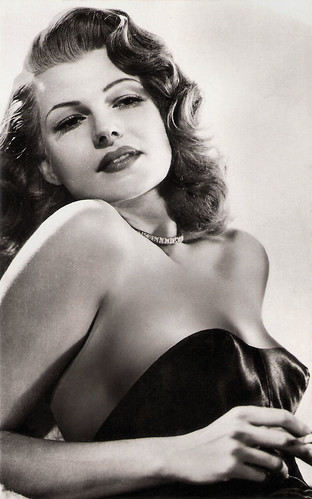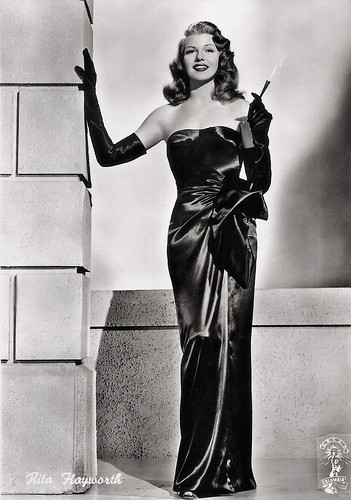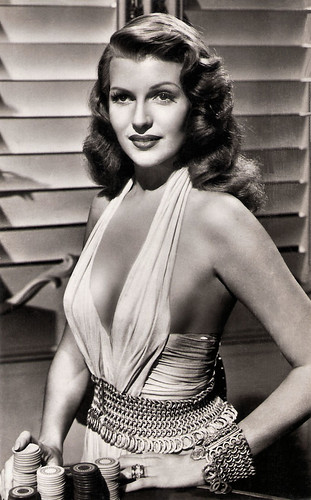Every evening the public of Cinema Ritrovato gathers at the Piazza Maggiore for a spectacular open air screening. One of these evening events is the screening of Gilda (Charles Vidor, 1946). Among the many attractions of this Film Noir is the sultry star of the film, Rita Hayworth. When she performs Put the Blame on Mame clad in lustrous black satin, she suggests a full striptease by only removing a glove. Gilda sealed Hayworth's reputation as Hollywood's leading love goddess of the 1940s.

Vintage card by IBIS, no. 23. Photo: Robert Coburn / Columbia Pictures. Publicity still for Gilda (Charles Vidor, 1946).

Italian postcard by Rotalfoto / Ediz. Garami, no. 54. Photo: Robert Coburn / Columbia Pictures / CEIAD. Publicity still for Gilda (Charles Vidor, 1946).

Spanish postcard, no. 4026. Photo: Robert Coburn / Columbia Pictures. Publicity still for Gilda (Charles Vidor, 1946).
Rita Hayworth (1918-1987) was the Brooklyn-born daughter of Spanish dancer Eduardo Cansino and Ziegfeld Follies showgirl Volga Haworth. She joined her family on stage when she was eight years old when her family was filmed in a movie called La Fiesta (1926). In the 1930s films, she made a few films under her real name, Margarita Cansino, and with her real hair colour (black). Her beauty would catapult her to international stardom.
Over the next few years - at the urging of Columbia Studios and her first husband - she reshaped her hairline with electrolysis, dyed her hair auburn, and adopted the name Rita Hayworth. She had her breakthrough as an unfaithful wife opposite Cary Grant in Only Angels Have Wings (Howard Hawks, 1939). In 1941 Hayworth took the screen opposite James Cagney in Strawberry Blonde (Raoul Walsh, 1941). That same year the 'American film goddess' shared the dance floor with Fred Astaire in You'll Never Get Rich (Sidney Lanfield, 1941). Her splendid dancing with Astaire made her a star.
Hayworth played her signature role as Gilda Mundson Farrell, the ultimate femme fatale in the Film Noir Gilda (Charles Vidor, 1946), co-starring Glenn Ford as a small-time gambler and her former flame. The film was also noted for cinematographer Rudolph Maté's lush photography, costume designer Jean Louis's wardrobe for Hayworth (particularly for the dance numbers), and choreographer Jack Cole's staging of Put the Blame on Mame and Amado Mio, sung by Anita Ellis. Hayworth sang the acoustic guitar version of Put the Blame on Mame herself.
The following year she starred in another Film Noir favourite, The Lady From Shanghai (1948), which was directed by her then-husband, Orson Welles. The film is best remembered for its final sequence when the plot comes to a literally smashing climax in the famous 'hall of mirrors' sequence, with Hayworth and Welles shooting it out amidst shards of shattering glass.
Hayworth starred in more than fifteen films in the two following decades including Miss Sadie Thompson (Curtis Bernhardt, 1953), Pal Joey (George Sidney, 1957) with Frank Sinatra and Circus World (Henry Hathaway, 1964) for which she earned a Golden Globe nomination.
During the 1960s, she also appeared in some European films such as I Bastardi/The Cats (Duccio Tessari, 1968) with Giuliano Gemma and Claudine Auger, and Sur la Route de Salina/The Road to Salina (Georges Lautner, 1970). Her career ended with Ralph Nelson's satirical Western The Wrath of God (1972) opposite Robert Mitchum.
Hayworth was suffering from the first symptoms of Alzheimer's disease. For years, she would be cared for by her daughter Princess Yasmin Khan, and her death from the disease in 1987 gave it public attention that led to increased funding for medical research to find a cure.
Rita, herself, said about her most famous role, "Men fell in love with Gilda, but they wake up with me". In person, Rita Hayworth was shy, quiet and unassuming. Only when the cameras rolled did she turn on the explosive sexual charisma that in Gilda (1946) made her a superstar.

Italian postcard by Bromofoto, Milano, no. 237. Photo: Robert Coburn / Columbia Pictures. Publicity still for Gilda (Charles Vidor, 1946).

Spanish card in the series Hollywood California, no. 4027. Photo: Robert Coburn / Columbia Pictures. Publicity still for Gilda (Charles Vidor, 1946).
Trailer Gilda (1946). Source: Danios12345 (YouTube).
Source: Lucia Bozzola (AllMovie), AllMovie, bio, Wikipedia and IMDb.

Vintage card by IBIS, no. 23. Photo: Robert Coburn / Columbia Pictures. Publicity still for Gilda (Charles Vidor, 1946).

Italian postcard by Rotalfoto / Ediz. Garami, no. 54. Photo: Robert Coburn / Columbia Pictures / CEIAD. Publicity still for Gilda (Charles Vidor, 1946).

Spanish postcard, no. 4026. Photo: Robert Coburn / Columbia Pictures. Publicity still for Gilda (Charles Vidor, 1946).
Ultimate femme fatale
Rita Hayworth (1918-1987) was the Brooklyn-born daughter of Spanish dancer Eduardo Cansino and Ziegfeld Follies showgirl Volga Haworth. She joined her family on stage when she was eight years old when her family was filmed in a movie called La Fiesta (1926). In the 1930s films, she made a few films under her real name, Margarita Cansino, and with her real hair colour (black). Her beauty would catapult her to international stardom.
Over the next few years - at the urging of Columbia Studios and her first husband - she reshaped her hairline with electrolysis, dyed her hair auburn, and adopted the name Rita Hayworth. She had her breakthrough as an unfaithful wife opposite Cary Grant in Only Angels Have Wings (Howard Hawks, 1939). In 1941 Hayworth took the screen opposite James Cagney in Strawberry Blonde (Raoul Walsh, 1941). That same year the 'American film goddess' shared the dance floor with Fred Astaire in You'll Never Get Rich (Sidney Lanfield, 1941). Her splendid dancing with Astaire made her a star.
Hayworth played her signature role as Gilda Mundson Farrell, the ultimate femme fatale in the Film Noir Gilda (Charles Vidor, 1946), co-starring Glenn Ford as a small-time gambler and her former flame. The film was also noted for cinematographer Rudolph Maté's lush photography, costume designer Jean Louis's wardrobe for Hayworth (particularly for the dance numbers), and choreographer Jack Cole's staging of Put the Blame on Mame and Amado Mio, sung by Anita Ellis. Hayworth sang the acoustic guitar version of Put the Blame on Mame herself.
The following year she starred in another Film Noir favourite, The Lady From Shanghai (1948), which was directed by her then-husband, Orson Welles. The film is best remembered for its final sequence when the plot comes to a literally smashing climax in the famous 'hall of mirrors' sequence, with Hayworth and Welles shooting it out amidst shards of shattering glass.
Hayworth starred in more than fifteen films in the two following decades including Miss Sadie Thompson (Curtis Bernhardt, 1953), Pal Joey (George Sidney, 1957) with Frank Sinatra and Circus World (Henry Hathaway, 1964) for which she earned a Golden Globe nomination.
During the 1960s, she also appeared in some European films such as I Bastardi/The Cats (Duccio Tessari, 1968) with Giuliano Gemma and Claudine Auger, and Sur la Route de Salina/The Road to Salina (Georges Lautner, 1970). Her career ended with Ralph Nelson's satirical Western The Wrath of God (1972) opposite Robert Mitchum.
Hayworth was suffering from the first symptoms of Alzheimer's disease. For years, she would be cared for by her daughter Princess Yasmin Khan, and her death from the disease in 1987 gave it public attention that led to increased funding for medical research to find a cure.
Rita, herself, said about her most famous role, "Men fell in love with Gilda, but they wake up with me". In person, Rita Hayworth was shy, quiet and unassuming. Only when the cameras rolled did she turn on the explosive sexual charisma that in Gilda (1946) made her a superstar.

Italian postcard by Bromofoto, Milano, no. 237. Photo: Robert Coburn / Columbia Pictures. Publicity still for Gilda (Charles Vidor, 1946).

Spanish card in the series Hollywood California, no. 4027. Photo: Robert Coburn / Columbia Pictures. Publicity still for Gilda (Charles Vidor, 1946).
Trailer Gilda (1946). Source: Danios12345 (YouTube).
Source: Lucia Bozzola (AllMovie), AllMovie, bio, Wikipedia and IMDb.
No comments:
Post a Comment